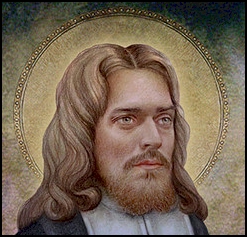Irish mothers are renowned for their sense of martyrdom, but one Irish martyr stands head and shoulders above all of them. Well, shoulders above them anyway. And Ireland’s current drought conditions have revealed the outline of his childhood home in County Meath. One of the Irish gifts that is part of life on this island is the incredible sense of history, the knowledge that we are walking in the footsteps of our ancestors. And every now and again, some new discovery enlightens us about the lives of our ancestors.
St. Oliver Plunket’s feast day in July 1st. And this July, conditions in Ireland lead to an amazing discovery. The freakish lack of rain and drought has lead to fields of dry, dead grass and soil shrinking due to lack of moisture. The outline of a house can now clearly be seen on the grounds of the estate where the Plunket’s home was. This outline matches the description in the 1612 civil survey of the area.
Plunket’s severed head is on display in St. Peter’s Church in nearby Drogheda, County Louth, and his name graces streets, schools and sports teams around Ireland. He is the patron saint of peace and reconciliation. Among his Irish gifts were determination and a fierce sense of community. He persisted in serving his people despite the danger.
Who Was St. Oliver Plunket?
St. Oliver Plunket was the last Irish Catholic martyr killed in England. Born in Loughcrew in 1629 to an affluent family with connections to various earls around Ireland, he went to study in Rome. While he was away, he was ordained a Catholic priest and Oliver Cromwell slaughtered people across Ireland. With Catholicism basically outlawed in Ireland, Plunket was unable to return without risking his life.
In 1669, Plunket was made Bishop of Armagh. The bloodshed had slowed, and it looked like the new regime might began to tolerate Catholics. Plunket returned to Ireland in 1670. He became known for preaching peace. The reprieve was short lived. In 1673, an edit banned bishops and he went into hiding. Things slowly settled down, and Plunket began to move around and live more normally, ministering to his people. But again, the calm was only temporary. In 1679, he was arrested and falsely charged with treason.
Plunket was brought to London, where he was unable to provide witnesses to testify in support of him. He was found guilty, and then hanged, disembowelled and quartered before a large crowd in Tyburn. He was beatified in 1920 and canonized in 1975.
The patron saint of peace and reconciliation doesn’t grace many Irish gifts. You won’t find tote bags or t-shirts bearing his likeness. But his impact on this nation was enormous. His life and death illustrate both the horrible suffering inflicted on Ireland and the people’s enormous strength and determination in resisting it. Plunket is one of the few saints who was canonized without being credited with performing any miracles. But the appearance of the outline of his childhood home does have a miraculous feel to it.

